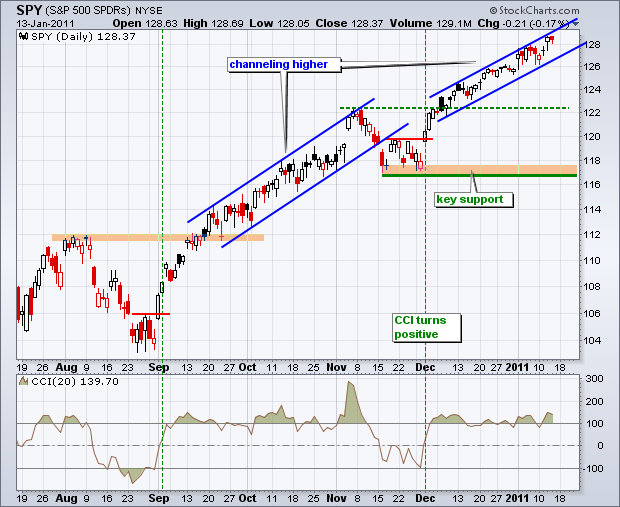Unsurprisingly, there is not change in the analysis of the daily or 60-minute charts. This December-January advance is looking awfully familiar. Looking back, we can see that SPY surged in early September, CCI became overbought and the ETF continued higher the next seven weeks. Looking at the current rally, we can see that SPY surged in early December, CCI became overbought and the ETF has been channeling higher the last 5 1/2 weeks. I am not going to try and equate the length of the first channel with the length of the second and predict a top in 10 days. However, I will note that the first channel ended after a big surge above 120. This was a buying climax. It may take a buying climax to reverse this channel.
On the 60-minute chart, SPY battled the lower trendline of the rising channel on Friday-Monday and surged on Tuesday-Wednesday. The ETF is now in the upper half of the channel and clearly in a short-term uptrend. The reaction lows affirm support at 126. RSI has also affirmed support in the 40-50 zone with its third bounce since mid December. This short-term uptrend remains in force until the ETF breaks 126 and RSI breaks 40. This short-term uptrend has been in force since the December 1st breakout (30 trading days).

Key Economic Reports:
Fri - Jan 14 - 08:30 - CPI
Fri - Jan 14 - 08:30 - Retail Sales
Fri - Jan 14 - 09:15 - Industrial Production
Fri - Jan 14 - 10:00 - Business Inventories
Charts of Interest: Tuesday and Thursday in separate post.
-----------------------------------------------------------------------------
This commentary and charts-of-interest are designed to stimulate thinking. This analysis is not a recommendation to buy, sell, hold or sell short any security (stock ETF or otherwise). We all need to think for ourselves when it comes to trading our own accounts. First, it is the only way to really learn. Second, we are the only ones responsible for our decisions. Think of these charts as food for further analysis. Before making a trade, it is important to have a plan. Plan the trade and trade the plan. Among other things, this includes setting a trigger level, a target area and a stop-loss level. It is also important to plan for three possible price movements: advance, decline or sideways. Have a plan for all three scenarios BEFORE making the trade. Consider possible holding times. And finally, look at overall market conditions and sector/industry performance.







